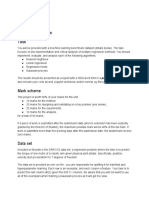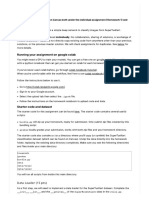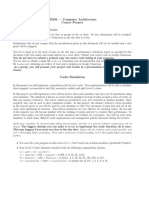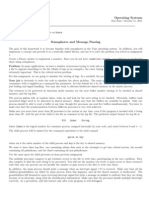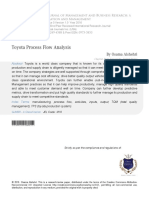AIM cw1 BPP 2024 04 08 1
Uploaded by
scyzw14Copyright:
Available Formats
AIM cw1 BPP 2024 04 08 1
Uploaded by
scyzw14Original Title
Copyright
Available Formats
Share this document
Did you find this document useful?
Is this content inappropriate?
Copyright:
Available Formats
AIM cw1 BPP 2024 04 08 1
Uploaded by
scyzw14Copyright:
Available Formats
Artificial Intelligence Methods (COMP2051 or AE2AIM)
Prof. Ruibin Bai Spring 2024
Coursework: Perturbative hyper-heuristic for Bin Packing Problem
1. Introduction
Bin packing is one of the most studied combinatorial optimisation problems and has
applications in logistics, space planning, production, cloud computing, etc. Bin packing is
proven to be NP-Hard and the actual difficulties depend on both the size of the problem (i.e.
the total number of items to be packed) and other factors like the distribution of item sizes in
relation to the bin size as well as the number of distinct item sizes (different items may have a
same size).
In this coursework, you are asked to write a C/C++/Python program to solve this problem
using a perturbative hyper-heuristic method. In addition to submitting source code, a
written report (no more than 2000 words and 6 pages) is required to describe your algorithm
(see Section 4 for detailed requirements). Both your program and report must be completed
independently by yourself. The submitted documents must successfully pass a plagiarism
checker before they can be marked. Once a plagiarism case is established, the academic
misconduct policies shall be applied strictly.
This coursework carries 45% of the module marks.
2. Bin Packing Problem (BPP)
Given a set of n items, each item j has a size of aj, BPP aims to pack all items in the
minimum number of identical sized bins without violating the capacity of bins (V). The
problem can be mathematically formulated as follow:
Artificial Intelligence Methods (COMP2051 or AE2AIM) Coursework Ver1.0 1
This mathematical formulation is generally NOT solvable by existing integer programming
solvers like CPlex, Gurobi, LPSolve, especially when the number of items n is large. The
solution space of bin packing problem is characterised by its huge size and plateau-like that
makes it very challenging for traditional neighbourhood search methods. In order to
consistently solve the problem with good quality solutions, metaheuristics and hyper-
heuristics are used, which is the task of this coursework.
3. Problem instances
Over the years, a large number of BPP instances have been introduced by various research.
See https://www.euro-online.org/websites/esicup/data-sets/ for a collection of different bin
packing problem. In this coursework, we shall provide 3 instances files (binpack1.txt,
binpack3.txt and binpack11.txt), respectively representing easy, medium and hard instances.
From which 10 instances shall be selected for testing and evaluation of your algorithm in
marking. For each test instance, only 1 run is executed, and its objective value is used for
marking the performance component (see Section 5).
4. Experiments conditions and submission requirements
The following requirements should be satisfied by your program:
(1) You are required to submit two files exactly. The first file should contain all your
program source codes. The second file is a coursework report. Please do NOT
compress the files.
(2) Your source code should adopt a clean structure and be properly commented.
Artificial Intelligence Methods (COMP2051 or AE2AIM) Coursework Ver1.0 2
(3) Your report should include the followings:
• The main components of the algorithm, including solution encoding, fitness
function, list of low-level heuristics as well as considerations regarding the
intensification and diversification mechanisms. (12 marks).
• Statistical results (avg, best, worst of 5 runs) of the algorithm for all the problem
instances, in comparison with the best published results (i.e. the absolute gap to
the best results). Note that although your report should include results for 5 runs
but your final submission should only have one single run for each instance (i.e.
if you use the sketch code from the lab, set global variable NUM_OF_RUNS=1
before you submit the code). (3 marks)
• A short discussion/reflection on results and performance of the algorithm. (5
marks)
(4) Name your program file after your student id. For example, if your student number
is 2019560, name your program as 2019560.c (or 2019560.cpp, or 2019560.py).
(5) Your program should compile and run without errors on either CSLinux Server or a
computer in the IAMET406. Therefore, please fully tested before submission. You
may use one of the following commands (assuming your student id is 2019560 and
your program is named after your id):
gcc -std=c99 -lm 2019560.c -o 2019560
or
g++ -std=c++11 -lm 2019560.cpp -o 2019560
For Python programs, this second can be skipped.
(6) After compilation, your program should be executable using the following
command:
./2019560 -s data_fle -o solution_file -t max_time
where 2019560 is the executable file of your program, data_file is one of
problem instance files specified in Section 3. max_time is the maximum time
permitted for a single run of your algorithm. In this coursework, maximum of 30
seconds is permitted. soluton_file is the file for output the best solutions by
your algorithm. The format should be as follows:
# of problems
Instance_id1
obj= objective_value abs_gap
item_indx in bin0
item_indx in bin1
… …
Instance_id2
obj= objective_value abs_gap
item_indx in bin0
Artificial Intelligence Methods (COMP2051 or AE2AIM) Coursework Ver1.0 3
item_indx in bin1
… …
An example solution file for problem data file “binpack1.txt” is available on
moodle.
For submissions using Python, the compilation and running are combined in one
command as follows:
python 2019560.py -s data_fle -o solution_file -t max_time
(7) The solution file output in (6) by your algorithm (solution_file) is expected to
pass a solution checking test successfully using the following command on
CSLInux:
./bpp_checker -s problem_file -c solution_file
where problem_file is one of problem data files in Section 3. If your solution file
format is correct, you should get a command line message similar to: “Your total score
out of 20 instances is: 80." If the solutions are infeasible for some instances, you would
get error messages.
The solution checker can be downloaded from moodle page. It is runnable only on
CSLinux.
(8) Your algorithm should run only ONCE for each problem instance and each run
should take no more than 30 seconds.
(9) Please carefully check the memory management in your program and test your
algorithm with a full run on CSLinux (i.e. running multiple instances in one go). In
the past, some submitted programs can run for 1-2 instances but then crashed
because of out-of-memory error. This, if happens, will greatly affect your score.
(10) You must strictly follow policies and regulations related to Plagiarism. You are
prohibited from using recent AI tools like ChatGPT/GPT-4 or other similar large
language models (LLMs). Once a case is established, it will be treated as a
plagiarism case and relevant policies and penalties shall be applied.
Artificial Intelligence Methods (COMP2051 or AE2AIM) Coursework Ver1.0 4
5. Marking criteria
• The quality of the experimental results (20 marks). Your algorithm shall be tested for
a file containing 10 instances chosen from the provided set of instances. The
performance of your algorithm is evaluated by computing the absolute gap with the
best known results using
𝑎𝑏𝑠_𝑔𝑎𝑝 = 𝑦𝑜𝑢𝑟_𝑎𝑣𝑒𝑟𝑎𝑔𝑒_𝑜𝑏𝑗𝑒𝑐𝑡𝑖𝑣𝑒 − 𝑏𝑒𝑠𝑡_𝑘𝑛𝑜𝑤𝑛_𝑜𝑏𝑗𝑒𝑐𝑡𝑖𝑣𝑒
Criteria Mark
New best results! Bonus: 2 extra marks for
abs_gap < 0
each new best result.
abs_gap <= 0 2 marks per instance
0<abs_gap <=1 1.5 marks per instance
1<abs_gap<=2 1 mark per instance
2< abs_gap <=3 0.5 mark per instance
• abs_gap >4 or
• infeasible solution or
0 mark
• fail to output solution
within required time limit
• The quality of codes, including organisation of the functions/methods, naming
conventions and clarity and succinctness of the comments (5 marks)
• Report (20 marks)
6. Submission deadline
3rd May 2024, 4pm Beijing Time
Standard penalties are applied for late submissions.
7. How to submit
Submit via Moodle.
8. Practical Hints
• Solution encoding for bin packing is slightly more challenging compared with
knapsack program because both the number of bins to be used and the number of
items to be packed in each bin are parts of decisions to be optimised. Therefore, the
Artificial Intelligence Methods (COMP2051 or AE2AIM) Coursework Ver1.0 5
data structure that is used to hold the packing information cannot be implemented via
fixed-size arrays. You may consider to use vector from C++ STL (standard template
library) which requires you to include <vector.h> as header file. If you prefer C style
without classes, the following data type would be also acceptable:
struct bin_struct {
std::vector<item_struct> packed_items;
int cap_left;
};
struct solution_struct {
struct problem_struct* prob; //maintain a shallow copy of problem data
float objective;
int feasibility; //indicate the feasibility of the solution
std::vector<bin_struct> bins;
};
In this way, you could open/close bins and at the same time to add/remove items for a
specific bin through API functions provided by the vector library.
• The search space of bin packing problem has a lot of plateaus that make the problem
extremely difficult for simple neighbourhood methods. Therefore, multiple low-level
heuristics are suggested within a perturbative hyper-heuristic method. You are free to
select any of the perturbative hyper-heuristic methods described in
(https://link.springer.com/article/10.1007/s10288-011-0182-8), as well as some of the
more recent ones
(https://www.sciencedirect.com/science/article/pii/S0377221719306526).
• Your algorithm must be runnable on CSLinux and/or computers on IAMET406.
Therefore, you are not permitted to use external libraries designed specifically for
optimisation.
Artificial Intelligence Methods (COMP2051 or AE2AIM) Coursework Ver1.0 6
You might also like
- Merlins Ralliart + Evox Tuning Guide - v2-0No ratings yetMerlins Ralliart + Evox Tuning Guide - v2-0136 pages
- Calculus and Its Applications 14th Edition Goldstein Test Bank 1100% (53)Calculus and Its Applications 14th Edition Goldstein Test Bank 153 pages
- History and Definition of Sobel OperatorNo ratings yetHistory and Definition of Sobel Operator5 pages
- QBUS6840 Group Assignment (30 Marks) : 1 Background and TaskNo ratings yetQBUS6840 Group Assignment (30 Marks) : 1 Background and Task3 pages
- Silicon Wafers: Find The Largest Defect-Free Area: 1 ProblemNo ratings yetSilicon Wafers: Find The Largest Defect-Free Area: 1 Problem3 pages
- ELL784/AIP701: Assignment 3: InstructionsNo ratings yetELL784/AIP701: Assignment 3: Instructions3 pages
- Exercise 2: Automata Theory: Finite State Automata - Theoretical ExercisesNo ratings yetExercise 2: Automata Theory: Finite State Automata - Theoretical Exercises6 pages
- CSE 5311: Design and Analysis of Algorithms Programming Project TopicsNo ratings yetCSE 5311: Design and Analysis of Algorithms Programming Project Topics3 pages
- EE204 - Computer Architecture Course ProjectNo ratings yetEE204 - Computer Architecture Course Project7 pages
- CS 211: Computer Architecture, Summer 2021 Programming Assignment 3: Cache Simulator (100 Points)No ratings yetCS 211: Computer Architecture, Summer 2021 Programming Assignment 3: Cache Simulator (100 Points)4 pages
- Report On OOPS C++ Training: January 2012No ratings yetReport On OOPS C++ Training: January 20123 pages
- Assignment 5 (Given: Dec 20, Due: Jan 8) - No ExtensionsNo ratings yetAssignment 5 (Given: Dec 20, Due: Jan 8) - No Extensions1 page
- FIT5196-S2-2020 Assessment 1: Task 1: Parsing Text Files (U)No ratings yetFIT5196-S2-2020 Assessment 1: Task 1: Parsing Text Files (U)4 pages
- Week 2 Project - Search Algorithms - CSMMNo ratings yetWeek 2 Project - Search Algorithms - CSMM8 pages
- Machine Learning With ML - Net and C# - VB - Net - CodeProjectNo ratings yetMachine Learning With ML - Net and C# - VB - Net - CodeProject17 pages
- Operating Winter 2019 Systems: Assignment 3No ratings yetOperating Winter 2019 Systems: Assignment 33 pages
- CIS 6213 Applied Machine Learning CourseworkNo ratings yetCIS 6213 Applied Machine Learning Coursework5 pages
- TensorFlow Developer Certificate Exam Practice Tests 2024 Made EasyFrom EverandTensorFlow Developer Certificate Exam Practice Tests 2024 Made EasyNo ratings yet
- Python Advanced Programming: The Guide to Learn Python Programming. Reference with Exercises and Samples About Dynamical Programming, Multithreading, Multiprocessing, Debugging, Testing and MoreFrom EverandPython Advanced Programming: The Guide to Learn Python Programming. Reference with Exercises and Samples About Dynamical Programming, Multithreading, Multiprocessing, Debugging, Testing and MoreNo ratings yet
- Chemical Engineering Computation: 1: Introduction To MATLABNo ratings yetChemical Engineering Computation: 1: Introduction To MATLAB35 pages
- Google's HRM Strategies Presentation-Ambesh Govind, MBA-4B - 078100% (1)Google's HRM Strategies Presentation-Ambesh Govind, MBA-4B - 07834 pages
- Toyota Process Flow Analysis: ToyotaprocessflowanalysisNo ratings yetToyota Process Flow Analysis: Toyotaprocessflowanalysis5 pages
- The Jesuit Conspiracy The Secret Plan of The Order 1848 PDF50% (2)The Jesuit Conspiracy The Secret Plan of The Order 1848 PDF331 pages
- Imanager U2000 V200R014C60 Web LCT User Guide 01 PDFNo ratings yetImanager U2000 V200R014C60 Web LCT User Guide 01 PDF144 pages
- GS33J01A10-01EN Main Centum VP Part Selection R6100% (1)GS33J01A10-01EN Main Centum VP Part Selection R640 pages
- Using Internet To Socialize (Advantage & Disadvantages)No ratings yetUsing Internet To Socialize (Advantage & Disadvantages)3 pages
- A First Course in Fuzzy and Neural Control - 2003 - Hung T. Nguyen Et AlNo ratings yetA First Course in Fuzzy and Neural Control - 2003 - Hung T. Nguyen Et Al305 pages
- Lifting - Secondary Chilled Water Pump Skid100% (1)Lifting - Secondary Chilled Water Pump Skid21 pages
- Release - Notes - Baseline - 2xxx - Plus Switch - v1.1.0.15 PDFNo ratings yetRelease - Notes - Baseline - 2xxx - Plus Switch - v1.1.0.15 PDF3 pages
- Calculus and Its Applications 14th Edition Goldstein Test Bank 1Calculus and Its Applications 14th Edition Goldstein Test Bank 1
- QBUS6840 Group Assignment (30 Marks) : 1 Background and TaskQBUS6840 Group Assignment (30 Marks) : 1 Background and Task
- Silicon Wafers: Find The Largest Defect-Free Area: 1 ProblemSilicon Wafers: Find The Largest Defect-Free Area: 1 Problem
- Exercise 2: Automata Theory: Finite State Automata - Theoretical ExercisesExercise 2: Automata Theory: Finite State Automata - Theoretical Exercises
- CSE 5311: Design and Analysis of Algorithms Programming Project TopicsCSE 5311: Design and Analysis of Algorithms Programming Project Topics
- CS 211: Computer Architecture, Summer 2021 Programming Assignment 3: Cache Simulator (100 Points)CS 211: Computer Architecture, Summer 2021 Programming Assignment 3: Cache Simulator (100 Points)
- Assignment 5 (Given: Dec 20, Due: Jan 8) - No ExtensionsAssignment 5 (Given: Dec 20, Due: Jan 8) - No Extensions
- FIT5196-S2-2020 Assessment 1: Task 1: Parsing Text Files (U)FIT5196-S2-2020 Assessment 1: Task 1: Parsing Text Files (U)
- Machine Learning With ML - Net and C# - VB - Net - CodeProjectMachine Learning With ML - Net and C# - VB - Net - CodeProject
- TensorFlow Developer Certificate Exam Practice Tests 2024 Made EasyFrom EverandTensorFlow Developer Certificate Exam Practice Tests 2024 Made Easy
- Python Advanced Programming: The Guide to Learn Python Programming. Reference with Exercises and Samples About Dynamical Programming, Multithreading, Multiprocessing, Debugging, Testing and MoreFrom EverandPython Advanced Programming: The Guide to Learn Python Programming. Reference with Exercises and Samples About Dynamical Programming, Multithreading, Multiprocessing, Debugging, Testing and More
- Chemical Engineering Computation: 1: Introduction To MATLABChemical Engineering Computation: 1: Introduction To MATLAB
- Google's HRM Strategies Presentation-Ambesh Govind, MBA-4B - 078Google's HRM Strategies Presentation-Ambesh Govind, MBA-4B - 078
- Toyota Process Flow Analysis: ToyotaprocessflowanalysisToyota Process Flow Analysis: Toyotaprocessflowanalysis
- The Jesuit Conspiracy The Secret Plan of The Order 1848 PDFThe Jesuit Conspiracy The Secret Plan of The Order 1848 PDF
- Imanager U2000 V200R014C60 Web LCT User Guide 01 PDFImanager U2000 V200R014C60 Web LCT User Guide 01 PDF
- Using Internet To Socialize (Advantage & Disadvantages)Using Internet To Socialize (Advantage & Disadvantages)
- A First Course in Fuzzy and Neural Control - 2003 - Hung T. Nguyen Et AlA First Course in Fuzzy and Neural Control - 2003 - Hung T. Nguyen Et Al
- Release - Notes - Baseline - 2xxx - Plus Switch - v1.1.0.15 PDFRelease - Notes - Baseline - 2xxx - Plus Switch - v1.1.0.15 PDF














